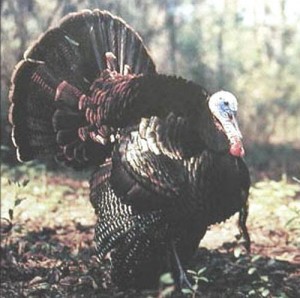The Wild Turkey is a large gallinaceous bird characterized by strong feet and legs adapted for walking and scratching, short wings adapted for short-rapid flight, a well-developed tail, and a stout beak useful for pecking. There are 2 species in the genus, the Wild Turkey of forested North America and the Ocellated Turkey (M. ocellata) of the Yucatan region of Central America (Eaton 1992). Hunting the Wild Turkey is a popular sport pursued by hunters nationwide..
According to historical records Wild Turkeys were very abundant in Texas before settlement, but as new immigrants occupied the region in the late 1800’s turkey populations suffered; largely as a result of wholesale habitat destruction and indiscriminant hunting. Statewide Wild Turkey populations remained low into the mid 1900’s; in 1959 the estimated population was just 100,000 (Oberholser 1974). But better protection, maturing of habitat, and trap and transplant of birds in the wild supported by sportsmen resulted in restoration of the species in Texas. By 1970 there was an estimated 575,000 Wild Turkeys in Texas, virtually all Rio Grande. In the later part of the 1900’s the eastern turkey was restored in eastern Texas.
DISTRIBUTION: Wild Turkeys are widespread in Texas, generally occurring where there is sufficient moisture to support grass and trees. The only extensive areas where they do not occur are in the very arid areas of the Trans-Pecos and the extensive prairies and agriculture areas of the high plains in the Texas Panhandle. There are 5 recognized subspecies of Wild Turkey, each associated with different habitat. Three subspecies occur in Texas. The Merriam’s turkey (M. g. Merriami) with white tail feather tips inhabit ponderosa pine habitat in the mountainous regions of the Trans-Pecos. The eastern turkey (M.g. silvestris), with dark color tail tips inhabits humid eastern Texas, and the Rio Grande turkey (M. g. intermedia), with buff colored tail tips is found throughout central Texas from Oklahoma to Mexico. Historically, eastern turkeys inhabited the Pineywoods and bottomland hardwoods of the southern coastal plain and oak-hickory forests; generally where annual rainfall was above 88 cm (35 in). Rio Grande turkeys are associated with the more arid brush lands westerly.
SEASONAL OCCURRENCE.During winter Wild Turkeys often will roost in large communal roosts, commonly in riparian zones with large trees. But with the onset of breeding season hens (followed by gobblers) will select other appropriate habitat to nest and raise their broods in suitable grass/forb vegetation. Often the nesting and brood range is some distance from winter range. Later in late summer or fall hens and their young and gobblers return to their traditional winter habitat.
BREEDING HABITAT: Separate flocks of gobblers and of hens break up in late winter as breeding activity begins. Mating occurs in late winter and early spring (March and April) and egg laying begins. The hen lays about 1 egg per day until the full clutch of about 10 or 11 eggs is complete. When laying the hen will cover her nest with leaves or other vegetation when she departs. When the clutch is complete she begins almost continuous incubation until the eggs hatch after 28 days. In Texas a few nests hatch in April, most in May, and some in the other warm months. Egg viability is high, usually about 90%.
Once all the poults pip the egg and hatch, dry off, and imprint on the hen and other poults, the hen leads them away from the nest site. The poults are precocious and began feeding soon afterwards. Young poults grow fast, have a high protein requirement, and consume a large quantity and variety of insects and other arthropods the first couple of weeks of life. After that but within their first month they gradually switch to mostly vegetative matter in their diet, such as grass seed and berries.
Turkey nests can be lost to predators and may be abandoned by nesting hens after disturbance. Nest success is usually 50% or less, but some hens unsuccessful in their first nesting attempt to renest. Poult mortality is high before they are developed enough to fly and roost in trees. Overall only about half or less of young poults survive to 2 weeks of age, but survival is much better after this critical period.
STATUS: Currently the Wild Turkey thrives in Texas. There are an estimated 500,000 to 600,000 Rio Grande turkeys in Texas supporting an annual harvest of around 100,000. Highest densities of Rio Grande turkeys are found in the Edwards Plateau and in a portion of the Rio Grande plains in South Texas. Annual productivity of the Rio Grande turkey depends mainly on rainfall and suitability of range conditions for reproduction. There are an estimated 16,000 eastern turkeys throughout eastern Texas, resulting from recent restoration. There is limited habitat and only a few hundred Merriam’s turkeys. Lockwood and Freeman (2004) consider Wild Turkey an uncommon resident from the eastern Panhandle southward through the Rolling Plains to the Edwards Plateau and common to uncommon in the South Texas Brush Country north of the lower Rio Grande valley, on the Central Prairies to Jackson County, and in the mountains of the central Trans-Pecos.
Text by James G. Dickson (Updated 2005)
Literature cited.
Eaton, S. W. 1992. Wild Turkey (Meleagris gallopavo). In The birds of North America, No. 22 (A. Poole and F. Gill, eds.). The Birds of North America, Inc., Philadelphia, PA.
Lockwood, M. W. and B. Freeman. 2004. The TOS handbook of Texas birds. Texas A&M University Press, College Station.
Oberholser, H. C. 1974. The bird life of Texas. University of Texas Press, Austin.

